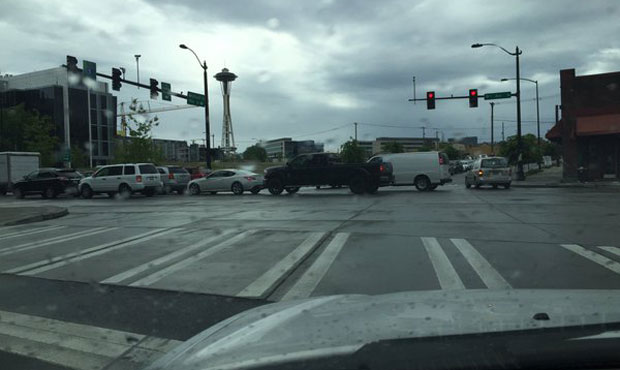Seattle to seek camera enforcement for block the box, bus lane violators
Jan 16, 2019, 5:35 AM | Updated: Oct 10, 2024, 12:21 pm

Cars block the box on Mercer Street. (KTTH, Jason Rantz)
(KTTH, Jason Rantz)
City officials have been telling us for weeks that even when the new Highway 99 tunnel opens, traffic in Seattle is not expected to improve.
RELATED: Will SPD hammer drivers with tickets, towing during viaduct closure?
It’s got city leaders looking at ways to ease congestion however they can, including with more enforcement cameras.
“We’re looking at the little things we can do to use our existing space more efficiently,” said Seattle City Councilmember Mike O’Brien. “There are a couple things that pop up. One is we have made more dedicated bus lanes because when a bus has 80 people on it, we want to get those 80 folks through as swiftly as possible and not be stuck in the same traffic.”
The problem is not everyone follows the rules.
“Vehicles will get in those lanes and block the bus traffic, so enforcement is a real challenge,” O’Brien explained. “Similarly, we find that on a regular basis at some intersections we have people blocking the box. You know people that come through a light when it’s in their favor, but there is no room on the other side of the intersection.”
He says that leads to chaos that puts everyone at risk.
“Some bicyclists will swerve out into traffic to get around it and it forces them out into the safe lane.” O’Brien said. “You have cars that are trying to sneak through, you have pedestrians walking in front of cars, behind cars, bicycles coming through. It is chaos.”
Blocking the box
“In the middle of that, all of a sudden, traffic will start moving, but there are a bunch of pedestrians in the crosswalk in front of the car and now the car really wants to get out of the way because they’re blocking a bus and they feel bad about it,” O’Brien said. “You know, it’s not the way the system is supposed to work.”
He says it causes a ripple effect that backs up the city.
The problem:
“Enforcement is a real challenge, and frankly, it’s not realistic to hire police officers to be at every single intersection and every single bus lane during rush hour and policing this,” O’Brien said. “They have more urgent things to be working on.”
The solution:
“If we had the authority to have a camera there and do camera enforcement and let everyone know, there would be warning periods and all of that type of stuff – but say, hey, there is a police officer there every single day so just don’t do it ever!” O’Brien said. “Behavior, we believe, would change pretty rapidly.”
Not about the money
O’Brien said the cameras wouldn’t be about raising revenue, but about punishing bad behavior.
“The goal would be that we put the camera up, we issue a few tickets and then no one does it anymore,” O’Brien said. “We don’t collect any more money but the streets operate much more effectively.”
O’Brien said they city needs help from the state Legislature to get the authority to set up the system.
At O’Brien’s transportation committee meeting Tuesday, council members got a brief update on what was needed. They agreed that getting the Legislature to sign off so they could begin implementation was a priority.
As for what would be done with any revenue raised?
“I’m open to them (legislators) to tell us how to spend whatever money we raise. Does it go toward more bus service or making the sidewalks safer? Whatever it is, it’s just the tool — the enforcement tool is what we really need,” O’Brien stressed.
“We could get 10 percent more efficiency in our system or something if we just didn’t have these blockages happening,” O’Brien said.
While cars that block the box would be fined under this proposal, buses and pedestrians would not.
“You are spending more tax dollars administratively processing those if they [buses] are ticketed by police,” said Seattle Police Homeland Security and Special Operations Chief Steve Hirjak.
As for pedestrians, Hirjak said, “Right now, during the squeeze, we really want to encourage pedestrian traffic as much as we can, at the same time we understand that it does impact traffic and we do take enforcement actions when –- at the officer’s discretion — they decide this person would be better served by being cited to correct behavior because again, that’s what it’s about. It’s not about hammering people, it’s not about getting revenue. It’s about trying to smooth it for everyone involved.”
Hirjak said they’ve also entered into an agreement with the Washington State Department of Transportation to conduct two pedestrian emphasis patrols sometime in 2019.














